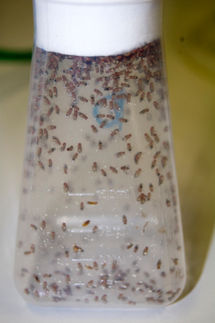CSHL scientists discover how a tumor suppressor induces senescence and staves off cancer
The tumor suppressor Retinoblastoma represses DNA replication genes during senescence
A frequently mutated gene in human cancers is the reitnoblastoma (RB) gene, which controls a potent tumor suppression pathway. mutations in the gene disable the vast and intricate RB pathway in virtually all tumor cells, leading to disturbances in a host of cellular functions and ultimately provoking cancer. But which of these functions is crucial for the gene's tumor-suppressing activity has been uncertain.
"We have now found that a key function of RB in suppressing cancer stems from its ability to induce cellular senescence, a stage of growth arrest in which cells no longer divide," explains Cold Spring Harbor Laboratory (CSHL) Professor and HHMI investigator Scott Lowe, Ph.D. His team's findings appear in the journal Cancer Cell.
RB's exact mode of activity has been difficult to tease out because it is part of a multigene family that includes two other members that are structurally very similar to RB and have highly overlapping functions. And yet, RB's activities appear to be a more vital part of cells' anti-cancer arsenal as compared to other RB family members, which are very rarely mutated in human cancers.
One of the cellular processes controlled by the RB family is cellular senescence, which is now known to act as a barrier against cancer. "So we hypothesized that the RB protein must exclusively target and control certain senescence-related proteins, which in turn must mediate its potent tumor- suppressive function," explains Lowe.
To investigate the relative effects of each RB family member on senescence, Lowe's team generated multiple short hairpin RNA (shRNA) molecules that specifically shut off individual RB family genes when introduced into human cells with intact RB networks. The team then switched on an oncogene in these cells, which normally triggers cells to cease dividing and enter the senescence mode as part of a failsafe mechanism that prevents cancer.
The team found that when RB alone was switched off, the cells could not efficiently undergo this process of oncogene-induced senescence. When these cells lost RB activity, they could not shut off DNA replication, began to replicate out of control and developed genomic instability. "These aberrant processes, when exacerbated by breakdowns in other control mechanisms, lead to the development of malignant tumors," says Agustin Chicas, Ph.D., a postdoctoral fellow working with Dr. Lowe and the lead investigator in the study.
Further investigations showed that a key target of RB is a gene called cyclin E1, which has been found to be overactive in many human tumors and is often associated with poor prognosis in patients. Its normal function is to spur DNA replication during the cell cycle and hence it is tightly suppressed by RB in senescent cells. The team showed that the loss of RB frees cyclin E1, thus allowing cells to escape senescence.
"Our team's findings suggest that the selective targeting of DNA replication genes during senescence represents one key activity of RB in tumor suppression," says Lowe.
Original publication: Agustin Chicas, Xiaowo Wang, Chaolin Zhang, Mila McCurrach, Zhen Zhao, Ozlem Mert, Ross A. Dickins, Masashi Narita, Michael Zhang, Scott W. Lowe; "Dissecting the Unique Role of the Retinoblastoma Tumor Suppressor during Cellular Senescence."; Cancer Cell 2010.
Most read news
Other news from the department science

Get the life science industry in your inbox
By submitting this form you agree that LUMITOS AG will send you the newsletter(s) selected above by email. Your data will not be passed on to third parties. Your data will be stored and processed in accordance with our data protection regulations. LUMITOS may contact you by email for the purpose of advertising or market and opinion surveys. You can revoke your consent at any time without giving reasons to LUMITOS AG, Ernst-Augustin-Str. 2, 12489 Berlin, Germany or by e-mail at revoke@lumitos.com with effect for the future. In addition, each email contains a link to unsubscribe from the corresponding newsletter.





















































